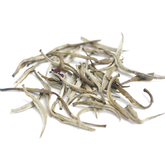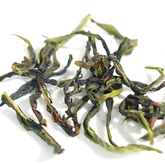A Complete Guide to White Tea Fuding Shou Mei: Origins, Taste, Brewing Tips, and Health Benefits
Among the world’s six major tea categories , there is one tea that remains almost untouched by human processing, preserving the tea leaf’s natural flavor and inner essence to the greatest extent. This is Fuding White Tea, an ancient tea variety from Fujian Province, China.
In the global tea world, white tea is renowned for its unique non-pan-frying and non-rolling processing, considered one of the most natural and pure Chinese teas. For those just beginning to explore Chinese tea, Fuding White Tea is an ideal choice because of its smooth and sweet taste, with minimal bitterness.
As a professional with many years of experience in Chinese tea sourcing, and having traveled extensively to Shoumei’s core production areas, this article will provide a comprehensive analysis of Fuding Shoumei—from origin and processing to flavor profile, brewing techniques, and buying guide.
Recommended purchase:
Chinese White Tea-Fuding Shou Mei 2025

Origin of Fuding Shoumei
Fuding White Tea is primarily produced in Fuding City , Ningde, Fujian Province, which is regarded as the hometown of Chinese white tea. Fujian sets the benchmark for China’s white tea production standards and boasts one of the largest tea planting areas in the country.
The raw materials for Shoumei come from tea gardens located in the misty mountainous regions surrounding Fuding. The pure air and mineral-rich soil give the tea its unique natural flavor.
Because Shoumei has relatively relaxed picking standards, its yield in Fuding exceeds that of Baihao Yinzhen and Baimudan, making it a high-quality white tea with stable production and affordable prices.
History of Fuding Shoumei
The concept of white tea was mentioned as early as the Tang Dynasty, but it wasn’t until the Jiaqing era of the Qing Dynasty (circa 1796) that white tea became an independent tea category with large-scale production. At that time, Fuding tea farmers created Baihao Yinzhen from tender buds, while older leaves with fine stems were sun-dried to produce the earliest Shoumei.
By the late 19th century, Shoumei began exporting to Hong Kong, Southeast Asia, Europe, and America. Because it can be stored long-term and is cheaper than Baihao Yinzhen, it became a daily tea for white tea enthusiasts. From the 1950s to 1970s, large amounts of loose Shoumei tea stored in humid warehouses in Hong Kong underwent natural aging, developing jujube and medicinal aromas and transitioning from astringent to sweet taste. This period marked the first market consensus that "aged white tea becomes more fragrant."
In 1984, Shoumei was awarded the title of “China Famous Tea,” and in 2011, Fuding white tea craftsmanship was included in the national intangible cultural heritage list. Today, Shoumei remains the largest exported white tea from Fuding and is regarded in Western markets as an “Oriental medicinal aroma” tea suitable for both drinking and aging.
How Is Fuding Shoumei Made?
The production of Shoumei adheres to the core principle of Fuding White Tea—no rolling, no pan-frying—maximizing the preservation of the tea leaf’s natural shape and content. This minimalistic, handcrafted, and natural processing retains the tea’s original vitality and pure taste, making it a truly natural beverage that is “from tea tree to cup” with almost no complex intervention.

The main steps rely heavily on manual work and natural forces:
Picking: Fresh leaves are hand-picked in spring and autumn, ensuring intact loose leaves.
Withering: The freshly picked Shoumei leaves are evenly spread on bamboo trays and naturally withered indoors with ventilation or under sunlight, allowing moisture to evaporate slowly. This softens the leaves and develops their characteristic aroma.
Drying: Once the leaves reach ideal withering levels, they are dried at low temperatures to quickly remove remaining moisture, fixing the tea quality and preventing spoilage.
What Does Fuding Shoumei Taste Like?
When tasting Fuding Shoumei, especially for those new to Chinese tea, it offers a uniquely delightful flavor experience. Shoumei’s aroma and taste evolve with storage time, showcasing its true charm and often challenging traditional Western perceptions of flavored teas.

Young Shoumei: Fresh and Naturally Sweet
Aroma: Clean, fresh, with subtle herbal notes often compared to wildflowers or dry hay.
Flavor: The brewed liquor is bright golden-yellow and clear. The taste is smooth and sweet without any bitterness.
Aged Shoumei: Rich and Mellow
Aroma: After 3, 5, or more years of proper storage, the fresh aroma transforms into a deeper, more complex fragrance featuring medicinal herbs and warm jujube notes, sometimes with hints of woodiness.
Flavor: The liquor darkens to deep amber or reddish-brown, with an exceptionally rich, full-bodied, and smooth taste, almost devoid of astringency, with increased sweetness.
How to Brew Fuding White Tea
Different brewing methods are recommended for new and aged Shoumei (aged over 3 years). Typically, young Shoumei is brewed with a Gongfu gaiwan , while aged Shoumei is best brewed in a Yixing clay teapot or by simmering.
Young Shoumei — Gongfu Brewing :
Tea-to-water ratio: 1:20 (4g tea per 100ml gaiwan)
Water temperature: Hot water cooled for 1 minute before brewing to enhance freshness and sweetness
Steeping time: Brew within 10 seconds; extend steeping if flavor fades.

Aged Shoumei — Yixing Clay Pot Brewing:
Tea-to-water ratio: 1:20 (5–7g tea per 100ml teapot)
Water temperature: Boiling water directly poured
Steeping time: Steep for 1 minute, then pour out to enjoy the richer brew

Aged Shoumei Winter Preparation — Slow Simmer:
Tea quantity: 8g of aged tea in 500ml cold water
Heating: Boil on high heat until bubbling, then simmer on low for 10 minutes before drinking

How to Store Fuding Shoumei Properly
Unlike many other teas, Fuding Shoumei has no strict shelf life. White tea improves with age and holds collectible value. When stored correctly, its flavor deepens and becomes more charming over time. Older white teas command higher prices.(Further Reading: Does Tea Expire? How to Properly Store Your Tea )

Sealed Storage: Store in opaque containers with airtight seals (ceramic or stainless steel jars) and remove excess air to slow oxidation and fragrance loss.
Dry and Moisture-Free: Keep in a dry place, away from humid areas like kitchens and bathrooms. Use food-grade silica gel packets to absorb moisture if necessary.
Avoid Light and Heat: Prevent exposure to direct sunlight or heat sources (water heaters, rice cookers). Ideal storage temperature is 15–25 °C. Prolonged heat or light accelerates quality degradation.
Health Benefits of Fuding Shoumei
Powerful Antioxidant Effects
Shoumei is rich in polyphenols, catechins, and flavonoids, especially EGCG (epigallocatechin gallate), which are widely studied potent antioxidants.
Supports Cardiovascular Health
Numerous studies indicate flavonoids in white tea, including Shoumei, positively affect cardiovascular health by improving endothelial function and promoting blood circulation, supporting healthy blood pressure levels (European Heart Journal, 2022, IF: 35.855).
Promotes Gut Health
Tea polyphenols not fully absorbed in digestion reach the colon and interact with gut microbiota. Research suggests this interaction helps regulate gut flora balance, promotes beneficial bacteria growth, and may inhibit harmful microbes, supporting digestive health (Gut Microbes, 2022, IF: 12.200).
Enhances Immune Defense
Tea polyphenols and flavonoids show antibacterial and antiviral properties. Moderate Shoumei consumption may strengthen the body’s natural immune defenses and help resist daily infections. In Chinese folk medicine, aged white tea is also widely believed to soothe sore throats (Frontiers in Immunology, 2023, IF=8.786).
Important Tips When Buying Fuding Shoumei
For Western consumers unfamiliar with Chinese tea, keep the following in mind to ensure you purchase authentic, high-quality Fuding White tea Shoumei:
Sample Before Bulk Purchase: Always try a small sample first to confirm taste and aroma meet your expectations.
Beware of Artificially Aged Tea: Some sellers artificially age tea through high heat and humidity, which damages true aged flavor and health benefits, sometimes causing off-odors or harmful substances.
Origin and Price Reflect Quality: Tea from the core production area commands higher prices and superior flavor. Cheaper teas from non-core areas may lack complexity.
Buy New Tea and Store for Aging: Because of Shoumei’s “better with age” nature, aged teas are more expensive. Beginners or budget buyers should purchase fresh Shoumei and store it properly for future enjoyment.
Summary of Fuding Shoumei
Fuding Shoumei is a lightly fermented white tea from Fuding, Ningde, Fujian Province, China.
As the largest volume, most affordable, and most aging-capable representative of Fuding white tea, it is a tea almost untouched by human processing, preserving the natural essence of tea leaves and delivering the purest original taste. Its smooth flavor makes it ideal for newcomers to Chinese tea.
Rich in polyphenols, catechins, and other antioxidants, Shoumei is widely believed to support cardiovascular health, gut health, and immune function. In Fujian, aged white tea is traditionally used to relieve sore throat. Drinking white tea is an excellent choice for those pursuing a healthy lifestyle.
FAQs About Fuding Shoumei
Q1: Does Shoumei white tea contain caffeine?
A: Yes, but at lower levels than green or black tea, and much less than coffee.
Q2: How much caffeine is in Shoumei white tea?
A: Approximately 15–30 mg per 240ml cup; aged tea tends to have less.
Q3: What does Shoumei white tea taste like?
A: Young tea is light, sweet, with herbal and floral notes; aged tea is rich, mellow, with jujube and aged aroma.
Q4: Is Shoumei suitable for long-term storage?
A: Yes, it gains flavor and value with aging if stored properly.
Q5: What are the benefits of drinking Shoumei white tea?
A: It contains natural antioxidants, helps refresh, supports skin health, and boosts immunity. Folk medicine holds that aged white tea soothes sore throats.
SEE MORE
If you are a beginner about Chinese tea:
Basic-Guide-to-Chinese-Tea
If you have questions about selecting tea:
Learn-more-about-chinese-tea
If you have questions about the benefits of tea:
Health-benefits-of-chinese-tea
If you have questions about brewing tea:
How-to-brew-loose-leaf-tea






